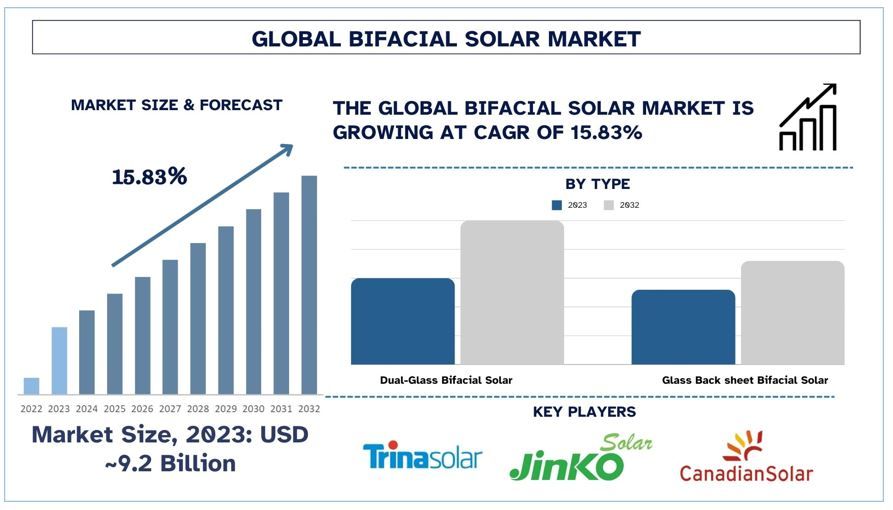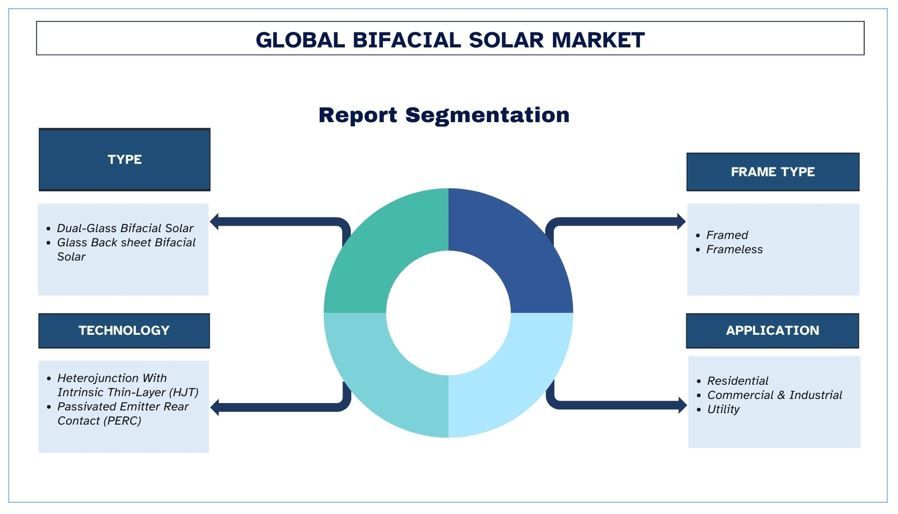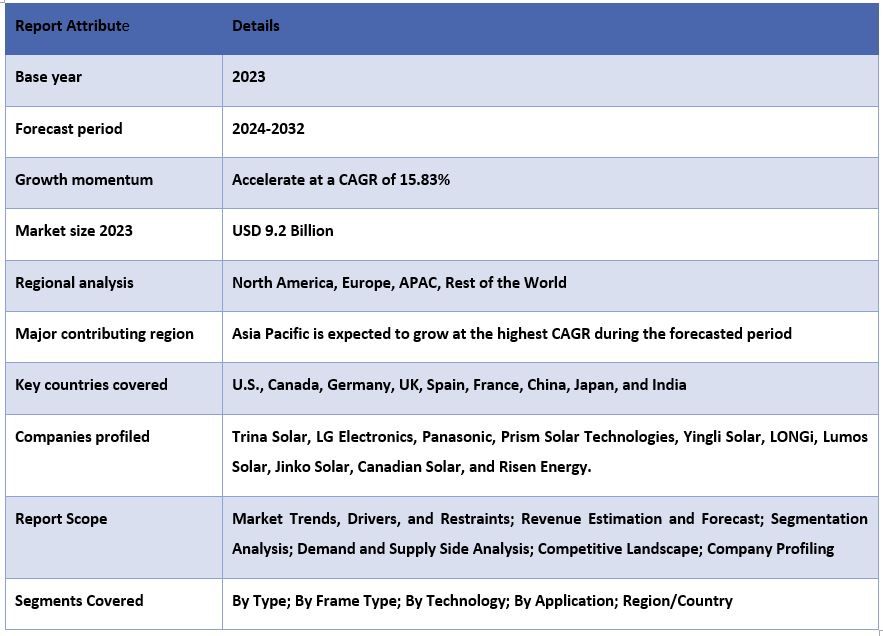- Home
- About Us
- Industry
- Services
- Reading
- Contact Us
Bifacial Solar Market: Current Analysis and Forecast (2024-2032)
Emphasis on Type (Dual-Glass Bifacial Solar and Glass Back Sheet Bifacial Solar); By Frame Type (Framed and Frameless); By Technology (Heterojunction With Intrinsic Thin-Layer (HJT); Passivated Emitter Rear Contact (PERC)); By Application (Residential, Commercial & Industrial, Utility); Region/Country

Bifacial Solar Market Size & Forecast
The Bifacial Solar market was valued at USD 9.2 Billion in 2023 and is expected to grow at a strong CAGR of around 15.83% during the forecast period (2024-2032). The bifacial solar market is still emerging due to the increasing demand for cost-effective and renewable energy sources worldwide. Compared to the monoracial panels, the bifacial solar panels have a light-capturing surface on the front side and the other surface can gather the reflected light. This two-faced power generation raises system efficiency by 10-30% depending on the conditions such as ground reflectivity and tilt. There has been noticeable interest in this technology in recent years because of its superior power density and low additional space/infrastructure demands.
Moreover, the increasing adoption of renewable energy, coupled with the emphasis on decarbonization and embracing sustainable energy sources, is the key factor for market growth. As technology advances and manufacturing costs lower, bifacial solar panels are expected to widely be adopted in commercial and residential markets and further the process of the global shift to using clean energy.
Bifacial Solar Market Analysis
The solar energy market has been developing constantly during the past ten years with the help of technology that influenced the prices and effectiveness of energy. One of the most promising is bifacial solar technology which has attracted attention because of the simultaneous generation on both the front and the rear surface of the panel. Furthering the need for renewables, bifacial solar panels have gained widespread application across different regions, applications, sectors, and commercial industries. This article examines the current and future market tendencies, the dynamics of bifacial modules’ implementation, and critical determinants of the bifacial panel price to better understand the nature of bifacial solar solutions’ impact on the world’s power generation outlook.
Bifacial Solar Market Trends
Innovation in PV Modules: Bifacial solar technology is emerging as an innovation in the PV market as it provides higher energy gains compared to mono-facial modules. Unlike traditional solar panels where only the front side captures the sun’s rays, the bifacial type produces current from both sides, and under specific mounting conditions, output could be boosted by up to 30%. These technological advancements have led to a focus on areas that receive high levels of irradiation, particularly in areas with reflective surfaces like snow, sand, or water this is because they increase power output.
The use of bifacial solar technology has shifted from residential and industrial rooftops to utility-scale power plants. The United States, China, India, and the Middle Eastern countries are now at the forefront of adopting bifacial solar farms due to their expansive space and high irradiance value. For instance, China’s Super League solar manufacturers such as LONGi and JA Solar have ramped up their production of bifacial modules enough to cater to the increasing market demand.

Asia Pacific is Expected to Grow with Significant CAGR During Forecast Period
Asia-Pacific has significantly contributed to the expansion of the Bifacial Solar market. It is mainly attributed to factors such as supportive government policies, a rising demand for clean energy, and the manufacturing capability of countries in the region. Some of the leading countries in the adoption of bifacial solar technology are China, India, Japan, and South Korea as they strive to meet their renewable power targets and shift from conventional sources of energy. Chinese companies including LONGi and JinkoSolar have also been involved in developing bifacial technology. Therefore, China is at the forefront of manufacturing and using the modules. Therefore, owing to strong government policies, enhanced manufacturing, and increasing requirements for effective renewable energy systems in the Asia-Pacific region, it is the leading market for bifacial solar.

Bifacial Solar Industry Overview
- The Bifacial Solar market is competitive and fragmented, with the presence of several global and international market players. The key players are adopting different growth strategies to enhance their market presence, such as partnerships, agreements, collaborations, new product launches, geographical expansions, and mergers and acquisitions. Some of the major players operating in the market are Trina Solar, LG Electronics, Panasonic, Prism Solar Technologies, Yingli Solar, LONGi, Lumos Solar, Jinko Solar, Canadian Solar, and Risen Energy.
Bifacial Solar Market News
- In 2021, LONGi unveiled its Hi-MO 5 bifacial module employing advanced HJT technology, with the product targeting utility-scale solar plants.
- In 2023, Canadian solar launched Biku bifacial modules – a glass-on-glass design that delivers high power output apt for utility-scale solar plants
Bifacial Solar Market Report Coverage

Reasons to buy this report:
- The study includes market sizing and forecasting analysis validated by authenticated key industry experts.
- The report presents a quick review of overall industry performance at one glance.
- The report covers an in-depth analysis of prominent industry peers with a primary focus on key business financials, product portfolios, expansion strategies, and recent developments.
- Detailed examination of drivers, restraints, key trends, and opportunities prevailing in the industry.
- The study comprehensively covers the market across different segments.
- Deep dive regional level analysis of the industry.
Customization Options:
The global Bifacial Solar market can further be customized as per the requirement or any other market segment. Besides this, UMI understands that you may have your own business needs, hence feel free to connect with us to get a report that completely suits your requirements.
Table of Content
Research Methodology for the Bifacial Solar Market Analysis (2024-2032)
Analyzing the historical market, estimating the current market, and forecasting the future market of the global Bifacial Solar market were the three major steps undertaken to create and analyze the adoption of Bifacial Solar in major regions globally. Exhaustive secondary research was conducted to collect the historical market numbers and estimate the current market size. Secondly, to validate these insights, numerous findings and assumptions were taken into consideration. Moreover, exhaustive primary interviews were also conducted, with industry experts across the value chain of the global Bifacial Solar market. Post assumption and validation of market numbers through primary interviews, we employed a top-down/bottom-up approach to forecasting the complete market size. Thereafter, market breakdown and data triangulation methods were adopted to estimate and analyze the market size of segments and sub-segments of the industry pertains to. Detailed methodology is explained below:
Analysis of Historical Market Size
Step 1: In-Depth Study of Secondary Sources:
A detailed secondary study was conducted to obtain the historical market size of the Bifacial Solar market through company internal sources such as annual reports & financial statements, performance presentations, press releases, etc., and external sources including journals, news & articles, government publications, competitor publications, sector reports, third-party database, and other credible publications.
Step 2: Market Segmentation:
After obtaining the historical market size of the Bifacial Solar market, we conducted a detailed secondary analysis to gather historical market insights and share for different segments & sub-segments for major regions. Major segments are included in the report as a type, frame type, technology, and application. Further country-level analyses were conducted to evaluate the overall adoption of testing models in that region.
Step 3: Factor Analysis:
After acquiring the historical market size of different segments and sub-segments, we conducted a detailed factor analysis to estimate the current market size of the Bifacial Solar market. Further, we conducted factor analysis using dependent and independent variables such as type, frame type, technology, and application of the Bifacial Solar market. A thorough analysis was conducted of demand and supply-side scenarios considering top partnerships, mergers and acquisitions, business expansion, and product launches in the Bifacial Solar market sector across the globe.
Current Market Size Estimate & Forecast
Current Market Sizing: Based on actionable insights from the above 3 steps, we arrived at the current market size, key players in the global Bifacial Solar market, and market shares of the segments. All the required percentage shares split, and market breakdowns were determined using the above-mentioned secondary approach and were verified through primary interviews.
Estimation & Forecasting: For market estimation and forecast, weights were assigned to varied factors including drivers & trends, restraints, and opportunities available for the stakeholders. After analyzing these factors, relevant forecasting techniques i.e., the top-down/bottom-up approach were applied to arrive at the market forecast 2032 for different segments and sub-segments across the major markets globally. The research methodology adopted to estimate the market size encompasses:
- The industry’s market size, in terms of revenue (USD) and the adoption rate of the Bifacial Solar market across the major markets domestically
- All percentage shares, splits, and breakdowns of market segments and sub-segments
- Key players in the global Bifacial Solar market regarding products offered. Also, the growth strategies adopted by these players to compete in the fast-growing market.
Market Size and Share Validation
Primary Research: In-depth interviews were conducted with the Key Opinion Leaders (KOLs) including Top Level Executives (CXO/VPs, Sales Head, Marketing Head, Operational Head, Regional Head, Country Head, etc.) across major regions. Primary research findings were then summarized, and statistical analysis was performed to prove the stated hypothesis. Inputs from primary research were consolidated with secondary findings, hence turning information into actionable insights.
Split of Primary Participants in Different Regions

Market Engineering
The data triangulation technique was employed to complete the overall market estimation and to arrive at precise statistical numbers for each segment and sub-segment of the global Bifacial Solar market. Data was split into several segments & sub-segments after studying various parameters and trends in the areas of type, frame type, technology, and application in the global Bifacial Solar market.
The main objective of the Global Bifacial Solar Market Study
The current & future market trends of the global Bifacial Solar market were pinpointed in the study. Investors can gain strategic insights to base their discretion for investments on the qualitative and quantitative analysis performed in the study. Current and future market trends determined the overall attractiveness of the market at a regional level, providing a platform for the industrial participant to exploit the untapped market to benefit from a first-mover advantage. Other quantitative goals of the studies include:
- Analyze the current and forecast market size of the Bifacial Solar market in terms of value (USD). Also, analyze the current and forecast market size of different segments and sub-segments.
- Segments in the study include areas of type, frame type, technology, and application.
- Define and analyze the regulatory framework for the Bifacial Solar
- Analyze the value chain involved with the presence of various intermediaries, along with analyzing customer and competitor behaviors of the industry.
- Analyze the current and forecast market size of the Bifacial Solar market for the major region.
- Major countries of regions studied in the report include Asia Pacific, Europe, North America, and the Rest of the World
- Company profile of the Bifacial Solar market and the growth strategies adopted by the market players to sustain in the fast-growing market.
- Deep dive regional level analysis of the industry
Frequently Asked Questions FAQs
Q1: What is the current market size and growth potential of the Bifacial Solar market?
Q2: What are the driving factors for the growth of the Bifacial Solar market?
Q3: Which segment has the largest share of the Bifacial Solar market by type?
Q4: What are the emerging technologies and trends in the Bifacial Solar market?
Q5: Which region will dominate the Bifacial Solar market?
Related Reports
Customers who bought this item also bought










